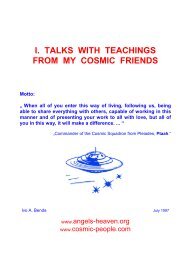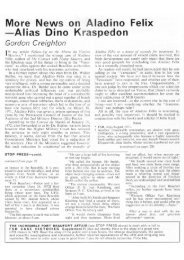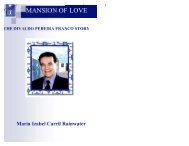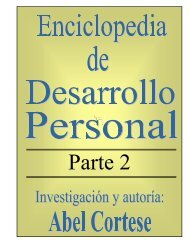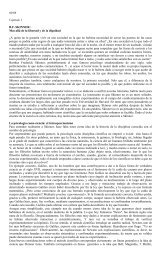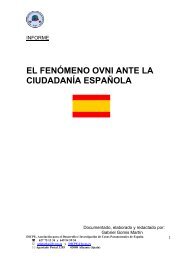The Word That is God
The Word That is God
The Word That is God
Create successful ePaper yourself
Turn your PDF publications into a flip-book with our unique Google optimized e-Paper software.
Syllable [Asvara]; Asvara which <strong>is</strong> a form of ex<strong>is</strong>tence should not be reckoned as non-ex<strong>is</strong>tence.<br />
<strong>That</strong> alone <strong>is</strong> Brahman which <strong>is</strong> div<strong>is</strong>ionless, non-differentiated and untinged.” (Amritabindu<br />
Upan<strong>is</strong>had, 7,8)<br />
<strong>The</strong> subject of the inner, mental Om as d<strong>is</strong>tingu<strong>is</strong>hed from the spoken Om <strong>is</strong> continued<br />
here. We must pass from the outer to the inner to the “silent” Om.<br />
By “ex<strong>is</strong>tence” the upan<strong>is</strong>had means Reality: Sat. Om <strong>is</strong> a form (manifestation) of Reality,<br />
of <strong>God</strong>, and should never be considered a mere word that <strong>is</strong> a part of relative ex<strong>is</strong>tence, or<br />
asat.<br />
“<strong>The</strong> Shabdakshara [sound-syllable: Om] <strong>is</strong> to be construed as the transcendental Brahman.<br />
When that Om has decayed, there underlies It the Akshara [the Undecaying]; if the knower of<br />
the atman should desire the peace of the atman he should meditate on that Akshara. 5 <strong>The</strong> two<br />
vidyas [knowledge] that ought to be known are the Shabda-Brahman [Sound Brahman] and<br />
that Brahman which transcends It. He who <strong>is</strong> well-versed in the Shabda-Brahman attains the<br />
transcendent Brahman.” (Amritabindu Upan<strong>is</strong>had, 16, 17)<br />
By “decay” <strong>is</strong> meant attenuation or diminution (dimin<strong>is</strong>hment) much as the organ stops<br />
that use the term “decay” to indicate fading, lessening, or d<strong>is</strong>solving of the sound. When the<br />
grosser forms of Om have faded away in meditation, then the underlying subtle forms are<br />
experienced and peace <strong>is</strong> found. <strong>The</strong> science of reaching the Transcendent Consciousness<br />
through the inner sound of Om <strong>is</strong> necessary for liberation (moksha). Om must be known in<br />
order to reach Its transcendent essence. <strong>The</strong>n “he who <strong>is</strong> well-versed in the Shabda-Brahman<br />
attains the transcendent Brahman.”<br />
“Om! Th<strong>is</strong> Syllable <strong>is</strong> Brahman. With Om alone he should breathe. With frequent application<br />
of th<strong>is</strong> divine sound he washes away the stains of the soul.” (Amritabindu Upan<strong>is</strong>had 20)<br />
Om <strong>is</strong> Brahman–not a mere symbol or verbal indicator of <strong>God</strong>. It verily <strong>is</strong> <strong>God</strong>–both as<br />
Sound and Consciousness. It <strong>is</strong> of utmost importance to realize that the Vedic scriptures ins<strong>is</strong>t<br />
on th<strong>is</strong> absolute identity of the Supreme Brahman with the mantric syllable Om. Om reveals<br />
<strong>God</strong> and Its–and our–identity with <strong>God</strong>. It <strong>is</strong> the key to liberation for the questing soul.<br />
<strong>The</strong>refore the repetition of Om should literally accompany our every breath in the practice of<br />
Om Yoga. For Om <strong>is</strong> not a mere reminder of <strong>God</strong>. It <strong>is</strong> the living Presence of <strong>God</strong>, the “divine<br />
Sound” which purifies the soul from all the impurities and defects we call “sins.” Om <strong>is</strong> the<br />
true Ganges, the true bapt<strong>is</strong>m, in which we immerse ourselves and wash away all that <strong>is</strong> not<br />
<strong>God</strong>. For that which <strong>is</strong> not <strong>God</strong> <strong>is</strong> “sin” and stains our soul.<br />
“<strong>The</strong>n he should meditate [on Om] and utter It repeatedly, more than repeatedly; for no<br />
excess here <strong>is</strong> too much.” (Amritabindu Upan<strong>is</strong>had 21)<br />
Continual practice <strong>is</strong> essential. Furthermore, what <strong>is</strong> considered “too much” by our lazy<br />
and limited standards <strong>is</strong> not too much. One of the deadliest flaws the spiritual aspirant can<br />
have <strong>is</strong> the attitude that spiritual life and practice can be overdone–that to be totally intent on<br />
and absorbed in spiritual practice (sadhana) at all times <strong>is</strong> unbalanced or fanatical. Only those<br />
of steady and uninterrupted effort, like the torto<strong>is</strong>e in the story, will succeed and win the<br />
prize. <strong>The</strong> “normal” hares are doomed to fail and lose the race by their very attitude.<br />
5 Th<strong>is</strong> <strong>is</strong> a play on words, for akshara means both imper<strong>is</strong>hable and syllable.<br />
8



